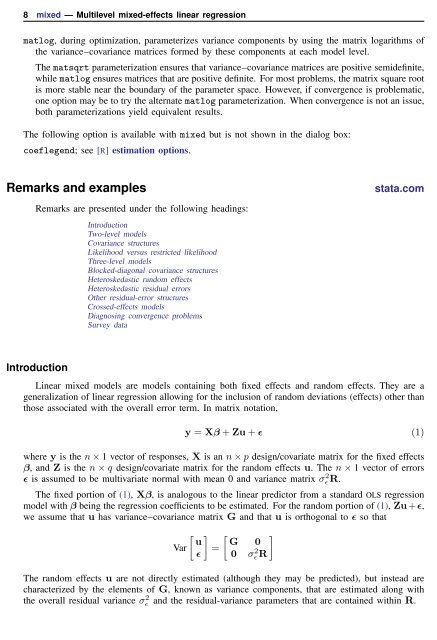mixed - Stata
mixed - Stata
mixed - Stata
You also want an ePaper? Increase the reach of your titles
YUMPU automatically turns print PDFs into web optimized ePapers that Google loves.
8 <strong>mixed</strong> — Multilevel <strong>mixed</strong>-effects linear regression<br />
matlog, during optimization, parameterizes variance components by using the matrix logarithms of<br />
the variance–covariance matrices formed by these components at each model level.<br />
The matsqrt parameterization ensures that variance–covariance matrices are positive semidefinite,<br />
while matlog ensures matrices that are positive definite. For most problems, the matrix square root<br />
is more stable near the boundary of the parameter space. However, if convergence is problematic,<br />
one option may be to try the alternate matlog parameterization. When convergence is not an issue,<br />
both parameterizations yield equivalent results.<br />
The following option is available with <strong>mixed</strong> but is not shown in the dialog box:<br />
coeflegend; see [R] estimation options.<br />
Remarks and examples<br />
stata.com<br />
Remarks are presented under the following headings:<br />
Introduction<br />
Two-level models<br />
Covariance structures<br />
Likelihood versus restricted likelihood<br />
Three-level models<br />
Blocked-diagonal covariance structures<br />
Heteroskedastic random effects<br />
Heteroskedastic residual errors<br />
Other residual-error structures<br />
Crossed-effects models<br />
Diagnosing convergence problems<br />
Survey data<br />
Introduction<br />
Linear <strong>mixed</strong> models are models containing both fixed effects and random effects. They are a<br />
generalization of linear regression allowing for the inclusion of random deviations (effects) other than<br />
those associated with the overall error term. In matrix notation,<br />
y = Xβ + Zu + ɛ (1)<br />
where y is the n × 1 vector of responses, X is an n × p design/covariate matrix for the fixed effects<br />
β, and Z is the n × q design/covariate matrix for the random effects u. The n × 1 vector of errors<br />
ɛ is assumed to be multivariate normal with mean 0 and variance matrix σ 2 ɛ R.<br />
The fixed portion of (1), Xβ, is analogous to the linear predictor from a standard OLS regression<br />
model with β being the regression coefficients to be estimated. For the random portion of (1), Zu+ɛ,<br />
we assume that u has variance–covariance matrix G and that u is orthogonal to ɛ so that<br />
[ ]<br />
u<br />
Var =<br />
ɛ<br />
[<br />
G 0<br />
]<br />
0 σɛ 2 R<br />
The random effects u are not directly estimated (although they may be predicted), but instead are<br />
characterized by the elements of G, known as variance components, that are estimated along with<br />
the overall residual variance σɛ 2 and the residual-variance parameters that are contained within R.
















